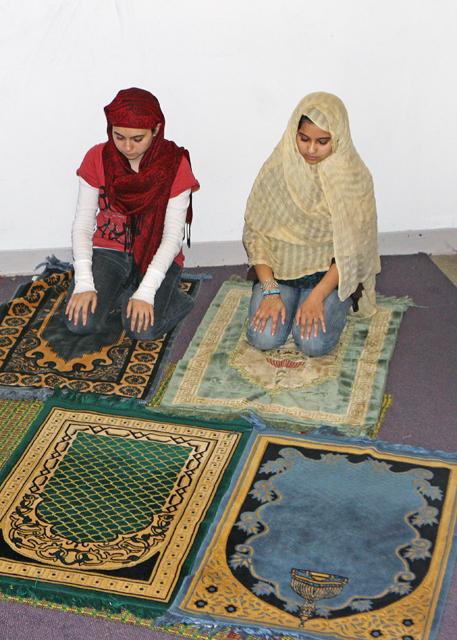
©
Talbia Choudhury, a junior in biochemistry, and Tahiti Choudhury, a sophomore in biological sciences, are in the fifth position of the Maghrib praying period. Muslim prayers, called salawat in Arabic, consist of multiple positions. These women pray on their prayer ruges, which are pointed toward the direction of the holy city of Mecca. Photo by Sarah Edens.
Exam week aside, far more praying is done at D.H. Hill Library than we think. To the left side of the library’s tower sits a modestly-sized prayer room, nestled in the bottom of a staircase. Although it’s tucked away and unknown to most students on campus, many Muslim students frequent this corner of the library, using it during prayer times throughout the day.
“One of the pillars of Islam is to pray,” Faiza Mustafa, sophomore in biological sciences, said. “When we’re at school, there’s no time to go home or to the mosque, so it’s a lot more convenient to have the library at school to pray.”
Compared to the rest of the library, the prayer room is relatively young. The room was established as an unofficial prayer room seven years ago when Aurelia Clayton, library facilities manager, walked by the staircase and spotted a student sitting down to pray. It was then that the idea of a prayer room was conceived. Clayton approached her supervisors and requested that the room be given to students. Thanks to Clayton and the help of other staff, Muslim students have been able to call the prayer room their own.
“One of the core principles of everyone who works in the library is to try to help any student be able to work better here,” Clayton said. “The suggestion of a space was received well and a lot of us were involved in coming up with a place where you could gather without distractions.”
But new as it may be, the number of students showing up to pray on a daily basis continues to grow.
“This semester, the number has increased drastically,” Mohammed Dorgham, sophomore in biochemistry, said. “It started from 5 [and is] currently 30.”
According to Islamic practice, Muslims are required to pray five, specific times of the day, with consideration to where the sun is located in the sky: at sunrise, noon, afternoon, sunset and night. During any of these times, a handful of students can be found in the prayer room. Due to growing followers and little capacity, students agree to take shifts to pray.
Crowdedness, however, is not a pressing issue on the minds of these students. To them, praying in a group is a blessing.
“The more people we pray with the better,” Mustafa said. “Not only are you meeting other Muslims, it’s also more rewarding than having to pray by yourself.”
The prayer room serves multiple purposes. While uniting the Muslim community on campus, it also provides flexibility amidst the busy schedules any typical college student possesses. For Muslims, religious traditions do not equate with convenience. Before performing prayers, Muslims must be ceremonially clean. Although the ablutions vary from sect to sect, they consist of: washing of the hands, arms, mouth and face in a systematic order before praying. Come prayer time, leaving the library to perform ceremonial cleansing interrupts studying patterns. But with the prayer space within proximity for those already in the library, students can choose to pray right where they study.
“It is amazingly convenient,” Dorgham said. “Most of the Muslims generally meet up in the library or learning commons so we can always pause our activities and go pray. We are very thankful to the library for allowing a space for us to perform our prayers.”
Additionally, the prayer room also serves as a haven for students living on campus. Mohamad Haidar, junior in biochemistry, lives with a non-Muslim and expressed his fondness for the space the prayer room provides.
“The prayer room is a calm, peaceful space where I can guarantee I will be able to concentrate during my prayer,” Haidar said. “I love that it is clean and that I may run into other Muslims there and pray alongside them.”
Contrasting the plain walls of the room, intricately designed prayer mats line the bottom of the stairwell, all of them uniquely filled with bold colors and decorated generously with Arabic patterns. Yet, there is one thing they hold in common: the mats all point towards Mecca, the universal direction in which all Muslims face while in prayer. Muslim students in prayer become a community in all aspects, down to the direction in which they pray. No matter where they are on campus or what it is they’re studying, the prayer room in D.H. Hill has become both a place of unity and worship for Muslims.
“It bonds our Muslim community on campus,” Ranya Samara, junior in mathematics education, said. “It’s great how sometimes we can all be studying, but when prayer time comes, we all make our way to the prayer room and perform our prayer.”